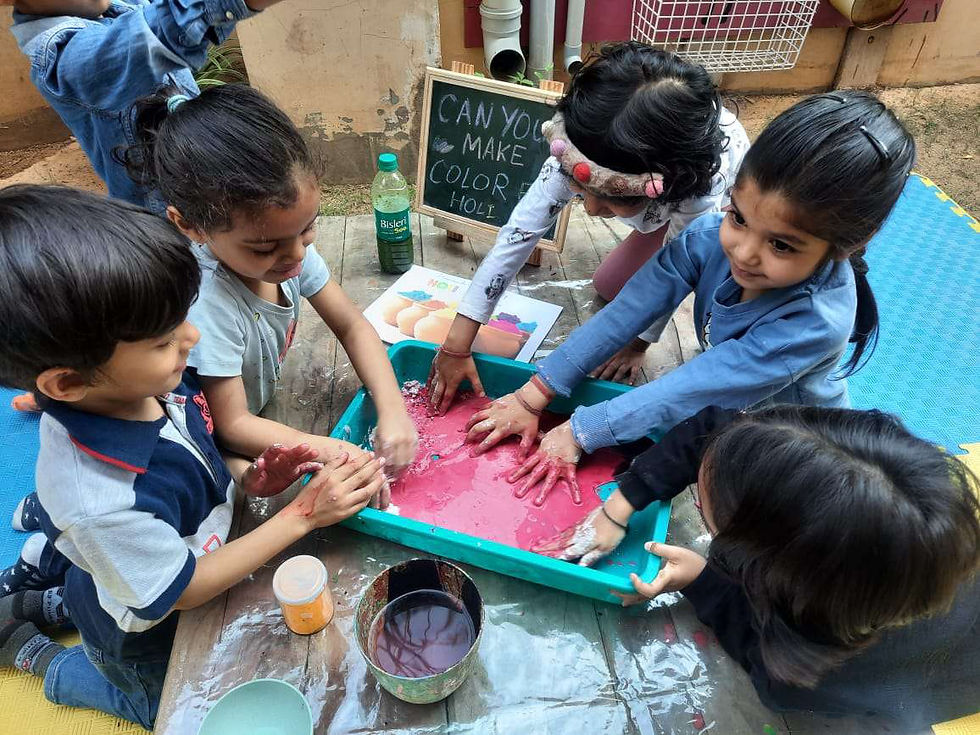Exploring Project Based Learning in Early Years
- GulmoharEarlyyears

- May 17, 2023
- 3 min read
As a founder of an early years program, I am always on the look out for creating environments where children can be engaged and learn by experience. In India, our teaching has been highly instructive giving little opportunities for children to explore, create, speak and discuss. As children grow older, teaching gets more scaffolded which gives them less opportunities to be involved. This continues and when they become adults and get in the real world , we find them struggle working in teams, being creative, taking ownership of their work and communicating their ideas in general.
What can we do in schools for our children to be more engaged in the process of learning in an integrated way? Project Based Learning (PBL) has been long around in the vernacular of K-12 pedagogies but it's potential is far from realised. Can we explore ways to bring it in the foundation years of our schooling which is the kindergarten?
At the heart of the Project based learning, the concept believes that children are responsible, investors, creative, process oriented and want to take ownership of their work. It is true that small children are more immersed in the immediate moment and enjoy the process than in the product of the activity. Incorporating projects gives children the opportunity to enjoy the process while working on their growth.

What is Project Based Learning ?
It is exploring a topic or a question about a topic in depth. The duration of a project can last from a few weeks to up to a year. In the process, a project usually involves integrated ways of learning - literacy, discussion, art, drama, music and movement etc. Most importantly, it takes into account the interests of the children.
How can we get started with PBL in the kindergarten classroom ?
Start with a topic, which interests your children. It should be something concrete, close to the personal experiences of the children. Brainstorm questions about it with your fellow staff members. Then ask questions about the topic to your children.
EXPLORE - Introduce the topic with some provocations and questions to the children. Observe what questions they ask or are interested to explore. This can become a starting point.
PLAY - Now with the topic and question in mind, go back to the drawing board and plan some activities for them. The activities can be of nature where children can explore materials, work in groups and have an element of play. This should get the children thinking about the project. Teachers should carefully observe the reactions, questions and ideas of the children.
DISCUSS / REPRESENTATION : Throughout the project the children should be given opportunities to represent their findings through different mediums - discussions, feelings about the activities and more questions.
REFLECT / DOCUMENT : Teachers should document their findings and observations on what input is coming from the children. Based on the current ideas of the children, the teachers create the further course of the project by incorporating their interests and making sure that integrated learning takes place by involving different mediums of learning.
This process can continue and based on the interests of children and scope of the project, the teachers can design a culminating experience to conclude the project.
What are the Benefits of this approach?
Children become more independent - they start thinking about questions and start taking steps to solve problems.
They take more ownership of their learning - Because teachers give them a chance to explore with materials and ask questions. Children take more ownership of what they learn.
Much better socio emotional learning - A lot of projects involve group activities which involve working with each other. This means helping out each other, listening to others and doing team work. Something a lot of us struggle at even in adulthood. Why not start early?
Integrated learning - In a project, we're involving multiple domains of learning. This means when learning about a topic, children learn through various means - discussions, explorations, constructions, drama, music and movement and much more. This means they are working on multiple subjects at the same time while exploring a question they care about. This is what organisations do when they work on real world problems.
It is challenging to introduce this approach as it requires lot of research and persistence on the part of educators. But introducing this approach in small doses can go a long way in tacking some fundamental problems with regards to learning in our global education system.



Comments